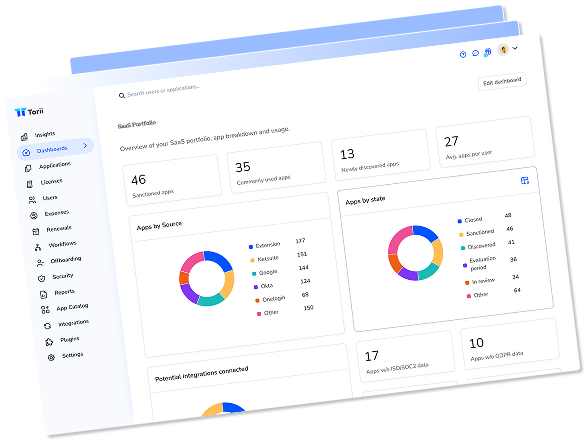One wrong click can bring entire organizations to their knees.
In an era where data breaches, ransomware, and sophisticated phishing scams grow more rampant by the day, cybersecurity has evolved from a technical concern into a global, multi-trillion-dollar imperative. Worldwide cybercrime costs are estimated to hit $10.5 trillion annually by 2025, underscoring just how high the stakes truly are.
As threats evolve, so must our awareness. Staying on top of trends has never been more important. To that end, we created a meta-analysis of what topics concern cybersecurity experts the most.
What We Did: To guide IT leaders and security professionals, we combed through the predictions and analyses of several top cybersecurity publications, aggregating their findings into clear, thematic trends. While these top results don’t necessarily guarantee which threats will prove the most likely, they do shed light on what a wide range of experts consistently expect to emerge or intensify. For those interested in drilling down into the individual sources we consulted, you’ll find a comprehensive list at the bottom of this piece.
1) AI in Cybersecurity
Times Mentioned: 21
Why It Matters
Artificial intelligence is emerging as a common thread linking nearly every major cybersecurity issue. Attackers and defenders alike leverage AI to scale their efforts—attackers employ AI for highly targeted phishing campaigns, malware generation, and deepfake-based social engineering. On the defensive side, security operations centers (SOCs) integrate machine learning (ML) and generative AI to automate threat detection, respond to incidents in real time, and address workforce gaps.
Key Insights
- Dual Use: AI improves efficiencies for defenders, but also creates “agentic” AI threats if malicious actors automate entire kill chains.
- Generative AI: Deepfakes, synthetic voice or video impersonation, and advanced spam/scam strategies are expanding.
- Data Transparency: Trust in AI tools requires clarity on data collection, model training, and security around AI pipelines.
Action Points
- Adopt AI-based threat detection and response platforms to keep pace with automated attacks.
- Provide staff training on AI-driven social engineering.
- Implement strong governance over internal AI/ML projects to ensure data integrity and compliance.
2) Regulations & Compliance
Times Mentioned: 7
Why It Matters
Global and fragmented regulations—ranging from general data protection (GDPR-like) to emerging AI governance—challenge organizations to maintain consistency across different jurisdictions. Noncompliance can result in severe financial penalties and reputational harm.
Key Insights
- Patchwork Landscape: State-by-state and international regulations vary, making cross-border business difficult.
- AI-Specific Rules: Many industry-watchers expect new mandates for AI usage and data protection.
- Incident Response Requirements: Regulators increasingly demand swift breach notification and robust crisis management plans.
Action Points
- Maintain an active regulatory watch to remain current on new cybersecurity requirements.
- Map data flows to ensure compliance with relevant laws in each jurisdiction of operation.
- Develop a formal incident response plan aligned with evolving regulatory frameworks.
3) Supply Chain Attacks
Times Mentioned: 5
Why It Matters
Recent high-profile breaches often start with a less-secure vendor or an open-source dependency, allowing attackers to pivot into larger enterprise networks. As organizations bolster their internal defenses, adversaries look for weaker external links.
Key Insights
- Third-Party Risks: Outsourced services, SaaS providers, and software libraries can act as critical entry points.
- Transparency Gaps: Organizations need clear visibility into the origin and security posture of code and data used by AI.
- Impact Amplification: A single compromise in the supply chain can cascade across numerous clients.
Action Points
- Conduct security assessments for all third-party services and vendors, including software Bill of Materials (SBOM).
- Implement monitoring systems to detect unusual activity stemming from external connections or dependencies.
- Include supply chain breach scenarios in tabletop exercises.
4) Cloud Security
Times Mentioned: 5
Why It Matters
Multi-cloud and hybrid environments compound security complexity. As more data and workloads move to the cloud, attackers see new opportunities for misconfiguration and identity-based exploits.
Key Insights
- Converged SOC: Merging cloud security monitoring with traditional SOC operations streamlines threat detection.
- CNAPP Trends: Cloud-Native Application Protection Platforms (CNAPPs) that integrate data security, posture management, and runtime defense are rising in popularity.
- Visibility Challenges: Decentralized control can lead to missed alerts or blind spots if tools are not unified.
Action Points
- Centralize logging and threat analytics across multi-cloud or hybrid environments.
- Adopt configuration management practices (infrastructure-as-code scanning, automated remediation).
- Align DevSecOps teams with cloud operations to address vulnerabilities earlier in the development process.
5) Ransomware
Times Mentioned: 4
Why It Matters
Ransomware remains a top threat globally, with attackers refining their tactics. Sophisticated gangs use AI to tailor ransom demands and exfiltrate data stealthily.
Key Insights
- Shift to “Stealth”: Rather than large-scale system lockouts, attackers may demand smaller, targeted ransoms multiple times.
- Data Exfiltration: Threat actors threaten to release sensitive data if companies do not pay.
- Post-Quantum Preparation: Some groups are encrypting stolen data now, anticipating future decryption with quantum computing.
Action Points
- Maintain continuous backups that are offline or immutable.
- Use advanced endpoint detection and response (EDR) solutions that incorporate AI and behavioral analytics.
- Develop a clear crisis management protocol, including stakeholder communication.
6) Geopolitical / Nation-State Threats
Times Mentioned: 4
Why It Matters
Nation-state actors and politically motivated groups are increasingly active, aligning cyber campaigns with geopolitical agendas. This leads to a rise in hacktivism, targeted espionage, and sabotage.
Key Insights
- Targeting Critical Infrastructure: Energy grids, healthcare systems, and supply chains remain prime targets.
- Hacktivism Upsurge: Cyber groups may form around geopolitical tensions to deface websites or disrupt public services.
- Cross-Border Collaboration: Some states collaborate with criminal gangs to expand the global reach of attacks.
Action Points
- Coordinate with government intelligence and information-sharing centers (ISACs) for sector-specific alerts.
- Implement segmented architectures to protect mission-critical systems from external networks.
- Train employees on advanced social engineering tactics often employed by nation-state groups.
7) Post-Quantum / Quantum Computing Risks
Times Mentioned: 4
Why It Matters
Quantum computing, while still emerging, presents a looming threat to current encryption standards. Malicious actors may be harvesting encrypted data now, planning to decrypt it once quantum becomes viable.
Key Insights
- “Harvest Now, Decrypt Later”: Sensitive data stolen today could be exposed years in the future.
- Quantum-Resistant Cryptography: New encryption methods (like lattice-based approaches) will be essential.
- Vendor Readiness: Hardware and software providers may begin shipping quantum-safe solutions ahead of demand.
Action Points
- Monitor NIST and similar organizations’ guidance on post-quantum cryptographic standards.
- Start inventorying critical data assets that will need quantum-resistant encryption.
- Develop long-term migration plans and test post-quantum solutions in pilot environments.
8) IoT / OT / ICS Security
Times Mentioned: 4
Why It Matters
The proliferation of Internet of Things (IoT) devices, along with Operational Technology (OT) in manufacturing, energy, and healthcare, expands the attack surface. Vulnerable endpoints can lead to significant disruptions or physical damage.
Key Insights
- Growing Attack Surface: Billions of connected sensors and devices lack robust security controls.
- SCADA Risks: Critical infrastructure systems, if compromised, can pose threats to public safety.
- Real-Time Constraints: OT environments often cannot afford downtime, limiting patching frequency.
Action Points
- Segment networks separating IT from OT environments.
- Regularly test and patch embedded systems despite operational constraints.
- Deploy specialized monitoring tools for industrial networks, focusing on anomaly detection.
9) Talent Shortage
Times Mentioned: 4
Why It Matters
Rising cybersecurity demands outpace the available workforce, leading to a near-constant shortage of skilled professionals. This gap hampers rapid incident response and strategic security initiatives.
Key Insights
- Automation Imperative: Many organizations rely on AI-driven automation to cover basic tasks and free human analysts for advanced work.
- Diverse Skill Sets: Beyond technical expertise, business acumen and regulatory knowledge are in high demand.
- Retention Challenges: Burnout and competitive salaries lead to high turnover rates in cybersecurity positions.
Action Points
- Invest in continuous training and upskilling, offering certifications and professional development.
- Explore automation for repetitive tasks, so analysts can focus on more complex threats.
- Expand recruitment pipelines (internships, partnerships with universities, diversity initiatives).
10) Evolving CISO Role
Times Mentioned: 3
Why It Matters
Cybersecurity is no longer just an IT function; it is a core business risk. CISOs must now engage with executive leadership, boards, and cross-functional teams, adding policy, communication, and strategic planning to their scope.
Key Insights
- Risk Partnership: CISOs increasingly partner with CFOs, CEOs, and boards to align cybersecurity with business objectives.
- Potential Fragmentation: Some organizations split CISO responsibilities into dedicated roles for data privacy, compliance, etc.
- Compensation & Liability: As responsibility grows, so does scrutiny—and with it, the potential for higher pay and personal liability.
Action Points
- Build communication skills to convey cybersecurity issues in business-friendly language.
- Develop risk management frameworks that tie cybersecurity strategies to revenue protection and brand reputation.
- Advocate for proactive investments in areas like zero trust and threat intelligence.
11) Zero Trust
Times Mentioned: 3
Why It Matters
Traditional perimeter-based security is ill-suited for modern, distributed environments. Zero trust frameworks emphasize strict identity verification and continuous monitoring of both users and devices.
Key Insights
- “Never Trust, Always Verify”: Ensures each resource request is validated in real time, mitigating lateral movement.
- Micro-Segmentation: Network segmentation plus identity-driven policies reduce the blast radius of breaches.
- Adoption Hurdles: Implementation requires significant cultural and infrastructural shifts, from re-architecting networks to training staff.
Action Points
- Develop a phased zero trust roadmap, starting with critical assets and high-risk user groups.
- Implement robust identity and access management (IAM) solutions, such as multi-factor authentication (MFA) and privileged access controls.
- Continuously monitor and log access requests for anomaly detection.
12) Data Privacy / PETs (Privacy-Enhancing Technologies)
Times Mentioned: 3
Why It Matters
Growing consumer awareness and stricter data laws underscore the need for advanced privacy measures. Organizations must protect sensitive data while balancing analytics and innovation.
Key Insights
- PET Adoption: Technologies like homomorphic encryption, secure multiparty computation, or differential privacy help secure data in use.
- Consumer Trust: Transparent data practices improve brand reputation.
- Regulatory Mandates: Data sovereignty regulations require local storage and processing, making privacy engineering more complex.
Action Points
- Classify and label data to apply appropriate privacy controls.
- Evaluate privacy-enhancing techniques that align with business needs, such as anonymized analytics.
- Communicate privacy commitments to customers, partners, and regulators to build trust.
Acknowledgment of Other Notable Topics
Several additional trends appeared but did not crack the top 12 in frequency of mentions. These include:
- Unified Security Platforms / Consolidation: The push for streamlined, all-in-one solutions to reduce tool sprawl.
- Open-Source Vulnerabilities: Risks inherent in widely used OSS libraries.
- Blockchain Security: Exploration of blockchain-based solutions for securing transactions, albeit with potential new exploitation paths.
- DDoS Attacks: Ongoing evolution of distributed denial-of-service campaigns.
- Cyber Insurance: Rising premiums and stricter underwriting criteria requiring proof of strong security controls.
- Innovation vs. Security Tensions: Balancing rapid development cycles with robust security guardrails.
While these did not appear as frequently, they remain critical areas for security professionals to monitor in the broader cybersecurity landscape.
References (All URLs Used)
- MSSPAlert — 8 Cybersecurity Trends and Opportunities for 2025
- Government Technology — The Top 25 Security Predictions for 2025, Part 1
- Wire Blog — Top Cybersecurity Trends 2025
- Centraleyes — Top Cybersecurity Trends to Watch Out For
- Coursera — Cybersecurity Trends
- NTT — Cybersecurity 2025
- Palo Alto Networks — 2025 Predictions Redefine the Cybersecurity Industry
- Dice — 5 Cybersecurity Trends for 2025 That Tech Pros Need to Know
- CompTIA — Cybersecurity Trends Research
- Proofpoint — AI, Data Security, and CISO Shifts: Top Cybersecurity Trends to Watch for 2025
- The Hacker News — 8 Cloud Security Trends

